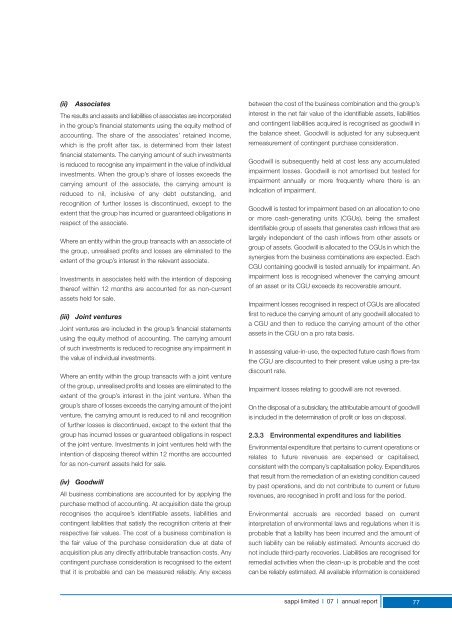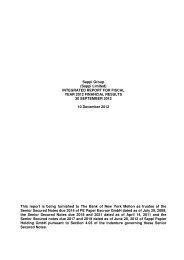2007 Annual Report - Sappi
2007 Annual Report - Sappi
2007 Annual Report - Sappi
Create successful ePaper yourself
Turn your PDF publications into a flip-book with our unique Google optimized e-Paper software.
(ii) Associates<br />
The results and assets and liabilities of associates are incorporated<br />
in the group’s financial statements using the equity method of<br />
accounting. The share of the associates’ retained income,<br />
which is the profit after tax, is determined from their latest<br />
financial statements. The carrying amount of such investments<br />
is reduced to recognise any impairment in the value of individual<br />
investments. When the group’s share of losses exceeds the<br />
carrying amount of the associate, the carrying amount is<br />
reduced to nil, inclusive of any debt outstanding, and<br />
recognition of further losses is discontinued, except to the<br />
extent that the group has incurred or guaranteed obligations in<br />
respect of the associate.<br />
Where an entity within the group transacts with an associate of<br />
the group, unrealised profits and losses are eliminated to the<br />
extent of the group’s interest in the relevant associate.<br />
Investments in associates held with the intention of disposing<br />
thereof within 12 months are accounted for as non-current<br />
assets held for sale.<br />
(iii) Joint ventures<br />
Joint ventures are included in the group’s financial statements<br />
using the equity method of accounting. The carrying amount<br />
of such investments is reduced to recognise any impairment in<br />
the value of individual investments.<br />
Where an entity within the group transacts with a joint venture<br />
of the group, unrealised profits and losses are eliminated to the<br />
extent of the group’s interest in the joint venture. When the<br />
group’s share of losses exceeds the carrying amount of the joint<br />
venture, the carrying amount is reduced to nil and recognition<br />
of further losses is discontinued, except to the extent that the<br />
group has incurred losses or guaranteed obligations in respect<br />
of the joint venture. Investments in joint ventures held with the<br />
intention of disposing thereof within 12 months are accounted<br />
for as non-current assets held for sale.<br />
(iv) Goodwill<br />
All business combinations are accounted for by applying the<br />
purchase method of accounting. At acquisition date the group<br />
recognises the acquiree’s identifiable assets, liabilities and<br />
contingent liabilities that satisfy the recognition criteria at their<br />
respective fair values. The cost of a business combination is<br />
the fair value of the purchase consideration due at date of<br />
acquisition plus any directly attributable transaction costs. Any<br />
contingent purchase consideration is recognised to the extent<br />
that it is probable and can be measured reliably. Any excess<br />
between the cost of the business combination and the group’s<br />
interest in the net fair value of the identifiable assets, liabilities<br />
and contingent liabilities acquired is recognised as goodwill in<br />
the balance sheet. Goodwill is adjusted for any subsequent<br />
remeasurement of contingent purchase consideration.<br />
Goodwill is subsequently held at cost less any accumulated<br />
impairment losses. Goodwill is not amortised but tested for<br />
impairment annually or more frequently where there is an<br />
indication of impairment.<br />
Goodwill is tested for impairment based on an allocation to one<br />
or more cash-generating units (CGUs), being the smallest<br />
identifiable group of assets that generates cash inflows that are<br />
largely independent of the cash inflows from other assets or<br />
group of assets. Goodwill is allocated to the CGUs in which the<br />
synergies from the business combinations are expected. Each<br />
CGU containing goodwill is tested annually for impairment. An<br />
impairment loss is recognised whenever the carrying amount<br />
of an asset or its CGU exceeds its recoverable amount.<br />
Impairment losses recognised in respect of CGUs are allocated<br />
first to reduce the carrying amount of any goodwill allocated to<br />
a CGU and then to reduce the carrying amount of the other<br />
assets in the CGU on a pro rata basis.<br />
In assessing value-in-use, the expected future cash flows from<br />
the CGU are discounted to their present value using a pre-tax<br />
discount rate.<br />
Impairment losses relating to goodwill are not reversed.<br />
On the disposal of a subsidiary, the attributable amount of goodwill<br />
is included in the determination of profit or loss on disposal.<br />
2.3.3 Environmental expenditures and liabilities<br />
Environmental expenditure that pertains to current operations or<br />
relates to future revenues are expensed or capitalised,<br />
consistent with the company’s capitalisation policy. Expenditures<br />
that result from the remediation of an existing condition caused<br />
by past operations, and do not contribute to current or future<br />
revenues, are recognised in profit and loss for the period.<br />
Environmental accruals are recorded based on current<br />
interpretation of environmental laws and regulations when it is<br />
probable that a liability has been incurred and the amount of<br />
such liability can be reliably estimated. Amounts accrued do<br />
not include third-party recoveries. Liabilities are recognised for<br />
remedial activities when the clean-up is probable and the cost<br />
can be reliably estimated. All available information is considered<br />
sappi limited | 07 | annual report 77
















